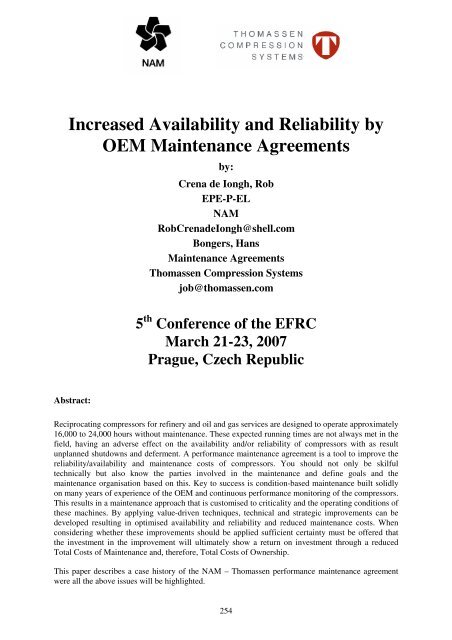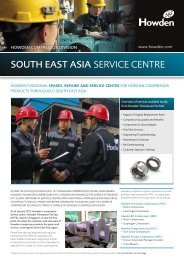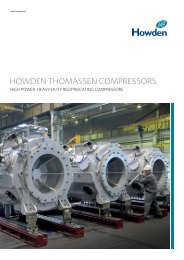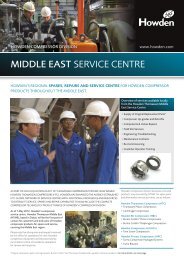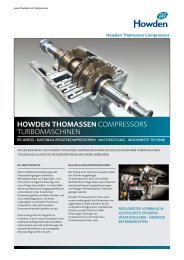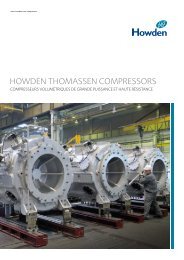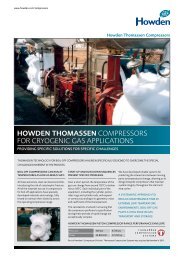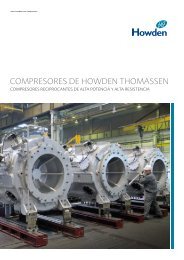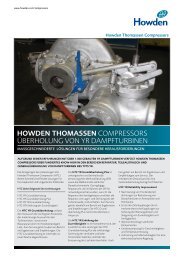Increased Availability and Reliability by OEM ... - Thomassen
Increased Availability and Reliability by OEM ... - Thomassen
Increased Availability and Reliability by OEM ... - Thomassen
Create successful ePaper yourself
Turn your PDF publications into a flip-book with our unique Google optimized e-Paper software.
<strong>Increased</strong> <strong>Availability</strong> <strong>and</strong> <strong>Reliability</strong> <strong>by</strong><br />
<strong>OEM</strong> Maintenance Agreements<br />
<strong>by</strong>:<br />
Crena de Iongh, Rob<br />
EPE-P-EL<br />
NAM<br />
RobCrenadeIongh@shell.com<br />
Bongers, Hans<br />
Maintenance Agreements<br />
<strong>Thomassen</strong> Compression Systems<br />
job@thomassen.com<br />
5 th Conference of the EFRC<br />
March 21-23, 2007<br />
Prague, Czech Republic<br />
Abstract:<br />
Reciprocating compressors for refinery <strong>and</strong> oil <strong>and</strong> gas services are designed to operate approximately<br />
16,000 to 24,000 hours without maintenance. These expected running times are not always met in the<br />
field, having an adverse effect on the availability <strong>and</strong>/or reliability of compressors with as result<br />
unplanned shutdowns <strong>and</strong> deferment. A performance maintenance agreement is a tool to improve the<br />
reliability/availability <strong>and</strong> maintenance costs of compressors. You should not only be skilful<br />
technically but also know the parties involved in the maintenance <strong>and</strong> define goals <strong>and</strong> the<br />
maintenance organisation based on this. Key to success is condition-based maintenance built solidly<br />
on many years of experience of the <strong>OEM</strong> <strong>and</strong> continuous performance monitoring of the compressors.<br />
This results in a maintenance approach that is customised to criticality <strong>and</strong> the operating conditions of<br />
these machines. By applying value-driven techniques, technical <strong>and</strong> strategic improvements can be<br />
developed resulting in optimised availability <strong>and</strong> reliability <strong>and</strong> reduced maintenance costs. When<br />
considering whether these improvements should be applied sufficient certainty must be offered that<br />
the investment in the improvement will ultimately show a return on investment through a reduced<br />
Total Costs of Maintenance <strong>and</strong>, therefore, Total Costs of Ownership.<br />
This paper describes a case history of the NAM – <strong>Thomassen</strong> performance maintenance agreement<br />
were all the above issues will be highlighted.<br />
254
OPERATIONS & MAINTENANCE<br />
<strong>Increased</strong> <strong>Availability</strong> <strong>and</strong> <strong>Reliability</strong> <strong>by</strong> <strong>OEM</strong> Maintenance Agreements, Hans Bongers; THOMASSEN COMPRESSION SYSTEMS<br />
Rob Crena de Iongh ; NAM<br />
1 Introduction<br />
Several parties are involved in the maintenance of<br />
compressors as is often the case when using <strong>and</strong><br />
maintaining capital goods. The parties involved do<br />
not necessarily have the same business interests.<br />
The easily recognised mutual interest for all parties<br />
with regard to maintenance is guaranteeing the<br />
availability <strong>and</strong> reliability of the machinery at issue<br />
while incurring acceptable costs. The opinions,<br />
regarding the required degree of availability,<br />
reliability <strong>and</strong> acceptable cost levels (<strong>and</strong> who<br />
should bear the costs), will often vary. Total Costs<br />
of Ownership <strong>and</strong> Total Costs of Maintenance are<br />
terms that can be easily confused. A saving on<br />
maintenance costs for one party can, after all, mean<br />
an increase in costs for the other party.<br />
A successful partnership in compressor maintenance<br />
requires being aware of the individual <strong>and</strong> joint<br />
interests of all involved parties as well as having<br />
sound technical knowledge. Success can be brought<br />
about <strong>by</strong> organising maintenance based on this<br />
awareness.<br />
The maintenance agreement that NAM concluded in<br />
2001 for its installed base of critical compressors<br />
with compressor manufacturer <strong>Thomassen</strong><br />
Compression Systems BV (<strong>Thomassen</strong>) has<br />
demonstrated that this can have good results in a<br />
customer - supplier relationship. The joint goal:<br />
maintaining the high availability <strong>and</strong> reliability<br />
while spending 20% less on maintenance costs.<br />
2 Parties involved<br />
Three parties are involved in the case under<br />
consideration: NAM, <strong>Thomassen</strong> <strong>and</strong>, to a lesser<br />
extent, also the Integrated Service Contractor (ISC).<br />
2.1 NAM<br />
NAM (Nederl<strong>and</strong>se Aardolie Maatschappij BV) is a<br />
subsidiary of Shell (51%) <strong>and</strong> Exxon/Mobil (49%).<br />
NAM’s mission is to explore gas <strong>and</strong> oil fields <strong>and</strong><br />
produce gas <strong>and</strong> oil in the Netherl<strong>and</strong>s <strong>and</strong> the<br />
Dutch part of the continental shelf in a sustainable<br />
way. The Netherl<strong>and</strong>s has 56% of all gas reserves in<br />
the European Union. NAM is responsible for 75%<br />
of the total Dutch gas production. Gas is supplied to<br />
the Gasunie, which is the main Gas trading<br />
company of the Netherl<strong>and</strong>s.<br />
Nowadays half of the produced gas comes from the<br />
Groningen gas field, the other half comes from<br />
smaller fields located elsewhere in the Netherl<strong>and</strong>s<br />
<strong>and</strong> offshore. NAM has to, in particular, deal with<br />
changing conditions in these smaller fields such as<br />
fluctuating pressures <strong>and</strong> gas compositions. This is<br />
why NAM has 50 reciprocating compressors<br />
installed, of which 34 are deployed as depletion<br />
units.<br />
Figure 1: Gas production/depletion in the<br />
Netherl<strong>and</strong>s <strong>by</strong> NAM<br />
The NAM Production organisation represents the<br />
realisation of the main goal of NAM: a reliable<br />
supply of gas. The gas must be delivered at the<br />
request of users with peak dem<strong>and</strong>s during the<br />
winter period. A guaranteed production capacity<br />
must, however, still be available when gas is less<br />
needed such as in the summer months.<br />
The NAM maintenance organisation is responsible<br />
for the maintenance <strong>and</strong> management of the<br />
maintenance budgets. The NAM maintenance<br />
strategy can be summarised as follows:<br />
−<br />
−<br />
−<br />
−<br />
Apply one maintenance strategy per<br />
criticality category;<br />
Optimise availability/reliability of units<br />
based on production requirement;<br />
Optimise effectiveness of maintenance;<br />
<strong>and</strong><br />
Improve supply chain performance.<br />
NAM has outsourced agreements to various service<br />
companies <strong>and</strong> different manufacturers of critical<br />
machines (compressors, electromotors, gas turbines,<br />
coolers, etc.) to implement this strategy.<br />
2.2 ISC<br />
The present main ISC (Integrated Service<br />
Contractor) for NAM is OMC.<br />
255
OPERATIONS & MAINTENANCE<br />
<strong>Increased</strong> <strong>Availability</strong> <strong>and</strong> <strong>Reliability</strong> <strong>by</strong> <strong>OEM</strong> Maintenance Agreements, Hans Bongers; THOMASSEN COMPRESSION SYSTEMS<br />
Rob Crena de Iongh ; NAM<br />
A holding company made up from several different<br />
contractors each with their own speciality. Main<br />
players are GTI, Tebodin <strong>and</strong> Imtech. This ISC<br />
contract was intended for all regular maintenance<br />
tasks, as well as breakdown <strong>and</strong> preventive<br />
maintenance. However, it has been recognised that<br />
OMC was not equipped to perform the maintenance<br />
tasks on more complex machines in accordance<br />
with the high st<strong>and</strong>ard NAM dem<strong>and</strong>s. Taking the<br />
high consequences of failure of these complex<br />
critical machines as well as the above statement into<br />
consideration, we have the main reasons why NAM<br />
decided to contract these machines out to the <strong>OEM</strong><br />
(Original Equipment Manufacturers).<br />
2.3 <strong>Thomassen</strong><br />
<strong>Thomassen</strong> is a compressor manufacturer with its<br />
main location in Rheden, the Netherl<strong>and</strong>s, <strong>and</strong> a few<br />
service companies around the world. <strong>Thomassen</strong><br />
has had NAM compressors under a maintenance<br />
agreement since 2001. This maintenance agreement<br />
has been extended to cover a total of 40 machines<br />
during the period from 2001 up to now.<br />
Compressors from various manufacturers are<br />
involved. <strong>Thomassen</strong> supplies the following within<br />
this agreement:<br />
− Maintenance management (coordination,<br />
planning, work preparation, reporting,<br />
engineering feedback);<br />
− Service personnel for the supervision of<br />
the planned <strong>and</strong> unplanned maintenance<br />
(carried out <strong>by</strong> the OMC);<br />
− Troubleshooting;<br />
− Component <strong>and</strong> spare part stocking;<br />
− Repair services;<br />
− Modification engineering;<br />
− Product engineering;<br />
− Training.<br />
Several issues must be compared <strong>and</strong> considered<br />
with regard to this. The most important ones are<br />
listed below.<br />
3.1 Maintainability<br />
The maintainability of a unit is an aspect which is<br />
mainly determined during the engineering stage of a<br />
unit. Part of this is in the design of the unit itself<br />
<strong>and</strong> the selection of materials <strong>and</strong> a part is in the<br />
access to the areas where maintenance is required<br />
<strong>and</strong> the ergonomics of this access. It must also be<br />
determined whether adequately instrumented units<br />
will provide the best opportunity for effective<br />
maintenance.<br />
The best design from a maintenance perspective<br />
may, however, not be the most inexpensive design<br />
with regard to purchase. A “saving” on the purchase<br />
of the new installation, ostensibly a saving for<br />
NAM, can result in higher maintenance costs <strong>and</strong><br />
ultimately to higher Total Costs of Ownership for<br />
NAM.<br />
3.2 Maintenance<br />
Making savings when it comes to maintenance<br />
budgets might improve short-term company results,<br />
but they will have a long-term adverse effect on<br />
availability <strong>and</strong> reliability.<br />
3.3 Assessment<br />
Basically, most users of capital goods believe that<br />
the main objective for maintenance is the<br />
improvement of availability <strong>and</strong> reliability while<br />
incurring an acceptable investment or cost level<br />
from a business economics perspective. The<br />
improvement of availability <strong>and</strong> reliability will<br />
quickly contribute to more production efficiency for<br />
production-critical machines.<br />
3 Goals <strong>and</strong> interests<br />
All the abovementioned parties are involved in<br />
developing the NAM maintenance strategy for its<br />
installed base of depletion/production compressors.<br />
We, naturally, have to deal with three companies<br />
that have their own business economics <strong>and</strong><br />
commercial goals. These interests must be managed<br />
in the elaboration of the maintenance agreement.<br />
First, however, there must be clarity about the<br />
assessment that NAM has made in relation to<br />
availability, reliability <strong>and</strong> the cost level.<br />
Figure 2: How to optimise Total Costs of<br />
Maintenance<br />
256
OPERATIONS & MAINTENANCE<br />
<strong>Increased</strong> <strong>Availability</strong> <strong>and</strong> <strong>Reliability</strong> <strong>by</strong> <strong>OEM</strong> Maintenance Agreements, Hans Bongers; THOMASSEN COMPRESSION SYSTEMS<br />
Rob Crena de Iongh ; NAM<br />
NAM has decided to have a maintenance cost<br />
reduction of 20% as its goal while retaining the<br />
current high availability <strong>and</strong> reliability of the<br />
critical machines <strong>and</strong>, where possible, making<br />
improvements.<br />
The challenge: to translate these goals into an<br />
approach <strong>and</strong> to define them in business <strong>and</strong><br />
commercially solid agreements.<br />
4 Approach<br />
The performance maintenance agreement that was<br />
concluded in 2001 with <strong>Thomassen</strong> was a<br />
continuation of an existing agreement based on a<br />
new <strong>and</strong> jointly chosen approach. <strong>Thomassen</strong> is<br />
responsible within this context for maintaining the<br />
high availability <strong>and</strong> reliability of the compressors<br />
under consideration as well as for realising the<br />
required cost saving of 20%.<br />
4.1 Economies of scale<br />
A significant part of the cost saving could be<br />
achieved <strong>by</strong> using the principle of economies of<br />
scale. <strong>Thomassen</strong> had already 21 compressors in its<br />
maintenance programme <strong>by</strong> the end of 2004. NAM<br />
was satisfied about the provided services <strong>and</strong><br />
wished to extend the existing maintenance<br />
agreement with an additional 19 machines in 2005.<br />
This meant that an important part, approximately<br />
half, of the contemplated savings could be brought<br />
about without there being any consequences that<br />
may affect availability <strong>and</strong> reliability. The<br />
economies of scale could be achieved <strong>by</strong> using the<br />
existing maintenance team, dedicated stocking <strong>and</strong><br />
supply of spare parts <strong>and</strong> infrastructure of<br />
<strong>Thomassen</strong>. The extension of the agreement was in<br />
the interest of both NAM (cost saving through<br />
economies of scale) <strong>and</strong> <strong>Thomassen</strong> (additional<br />
business). A clear win-win deal.<br />
4.2 Sophisticated service levels per<br />
machine category<br />
A second part of the saving could be brought about<br />
<strong>by</strong> better harmonising service levels to machine<br />
categories. Two aspects played a role in this:<br />
1. The criticality of a compressor function<br />
within the process installation.<br />
2. The level of complexity <strong>and</strong> expertise<br />
required.<br />
The first aspect is the easiest to determine <strong>and</strong><br />
results in an obvious approach. Machines for which<br />
the availability in the production process is less<br />
critical, require a lower degree of maintenance<br />
investment.<br />
The second aspect is more interesting. An<br />
intelligent service approach was defined for each<br />
machine category based on the knowledge,<br />
experience <strong>and</strong> history that were built up <strong>by</strong> NAM<br />
<strong>and</strong> <strong>Thomassen</strong> <strong>and</strong> through the <strong>Thomassen</strong> PPMO<br />
method.<br />
PPMO st<strong>and</strong>s for Pro-active Performance <strong>and</strong><br />
Maintenance Optimiser <strong>and</strong> is the <strong>Thomassen</strong>'s tool<br />
to implement a condition-based maintenance<br />
strategy on compression equipment. PPMO<br />
combines data that is collected during operation <strong>and</strong><br />
performance inspections <strong>and</strong> during mechanical<br />
inspections. The purpose is to assess the condition<br />
of the units <strong>and</strong> to predict the lifetime of the critical<br />
parts, in order to execute maintenance before<br />
failures occur. The inspections are planned based on<br />
running time frequency, maintenance intervention<br />
frequency, together with the historical performances<br />
of the relevant machine.<br />
In order to minimise the Total Cost of Maintenance<br />
of each unit while retaining the required reliability,<br />
a production criticality assessment has led to the<br />
definition of different service levels with connected<br />
work scopes.<br />
Different service levels were determined to specify<br />
the most appropriate fit for purpose maintenance<br />
strategy, where:<br />
−<br />
−<br />
Service level A is a condition based<br />
maintenance strategy which is specified for<br />
units which are critical to NAM operations<br />
<strong>and</strong> which require high maintenance<br />
support.<br />
Service level B is a condition-based<br />
maintenance strategy which is specified for<br />
units which are critical to NAM operations<br />
<strong>and</strong> which require medium maintenance<br />
support.<br />
− Service level C is a time-based<br />
maintenance strategy which is specified for<br />
units which are not critical to NAM<br />
operations <strong>and</strong>/or has specific reasons why<br />
a low maintenance support is required.<br />
257
OPERATIONS & MAINTENANCE<br />
<strong>Increased</strong> <strong>Availability</strong> <strong>and</strong> <strong>Reliability</strong> <strong>by</strong> <strong>OEM</strong> Maintenance Agreements, Hans Bongers; THOMASSEN COMPRESSION SYSTEMS<br />
Rob Crena de Iongh ; NAM<br />
−<br />
A separate service level 0 is defined for<br />
units which are being implemented for<br />
maintenance for one year. The scope will<br />
contain additional calibration of unit data,<br />
condition spare parts, history <strong>and</strong><br />
behaviour.<br />
The remaining part of the saving could be achieved<br />
through the sophisticated service levels for each<br />
machine category <strong>and</strong> the definition of maintenance<br />
clusters.<br />
4.3 Long-term vision<br />
This maintenance concept only works if it is<br />
concluded for several years because then there are<br />
real opportunities to introduce improvements <strong>and</strong> to<br />
show their effect. Long-term commitment <strong>by</strong> both<br />
parties gives security <strong>and</strong> confidence to concentrate<br />
on joint interests.<br />
Figure 3: Service Levels for NAM compressors<br />
The maintenance budgets consist mainly of costs for<br />
personnel, training, parts, tools, outsourcing <strong>and</strong><br />
stocking. Savings could be realised <strong>by</strong> shorter<br />
turnaround times with regard to maintenance<br />
activities <strong>and</strong> stretching the time in-between<br />
maintenance interventions.<br />
In stocking parts, mayor savings can be created <strong>by</strong><br />
intelligent warehousing, logistics, insurances <strong>and</strong><br />
the prevention of locking up capital.<br />
Costs can also be controlled <strong>by</strong> clustering<br />
maintenance activities. The scope of a maintenance<br />
cluster is determined <strong>by</strong> a logical combination of<br />
maintainable parts having similar life span<br />
expectancies. For example: cluster valves that have<br />
compressor valves with O-rings <strong>and</strong> gaskets. Cluster<br />
stuffing boxes that have stuffing boxes,<br />
compartment seals, rider rings <strong>and</strong> piston rings with<br />
all necessary gaskets <strong>and</strong> small items.<br />
Life span expectancy of every maintenance cluster<br />
can be monitored via inspections, job reporting <strong>and</strong><br />
refurbishment reports. Life span increase for a<br />
complete cluster will both result in reduced<br />
maintenance costs <strong>and</strong> will improve availability.<br />
Compressor / Serial No. Cluster Cluster Cluster Cluster<br />
A B C D<br />
K-2101 / 1300 12.000 24.000 52.000 40.000<br />
Fixed Date 18-01-2001 20-01-2003 18-01-2001 18-01-2001<br />
K-2201 / 1409 16.000 24.000 52.000 40.000<br />
Fixed Date 20-01-2003 20-01-2003 18-01-2001 18-01-2001<br />
K-2202 / 1410 16.000 24.000 52.000 40.000<br />
Fixed Date 20-01-2003 20-01-2003 18-01-2001 18-01-2001<br />
K-8 / 1411 16.000 24.000 52.000 40.000<br />
Fixed Date 13-07-2000 13-07-2000 21-05-2001 18-01-2001<br />
K-9 / 1412 16.000 24.000 52.000 40.000<br />
Fixed Date 21-10-2003 20-01-2003 18-01-2001 18-01-2001<br />
K-602 / 11081/411 16.000 24.000 52.000 40.000<br />
Fixed Date 18-01-2001 19-06-2001 18-01-2001 18-01-2001<br />
K-9100 Den Helder 8.000 16.000 32.000 40.000<br />
Dresser 26-01-2006 26-01-2006 26-01-2006 26-01-2006<br />
Cluster A = Replace Valves<br />
Cluster B = Replace Compartment seals - Piston rings - Rider rings - Stuffingboxes<br />
Cluster C = Replace Piston rods<br />
Cluster D = Replace Crosspin bushings- Small-end bearings<br />
Cluster E = Replace Liners<br />
Cluster F = Replace Big-end bearings - Main bearings - Crosspins - Crosshead shoes<br />
Cluster Y = Performance Inspection, Pro-active Performance & Maintenance Optimizer<br />
Cluster Z = Mechanical Inspection, Pro-active Performance & Maintenance Optimizer<br />
Figure 4: Clusters with life span<br />
The maintenance agreement between NAM <strong>and</strong><br />
<strong>Thomassen</strong> was concluded for a period of 5 plus 5<br />
years. The long-term horizon supports <strong>and</strong> promotes<br />
making improvement proposals. An example is the<br />
commitment of the maintenance team during the<br />
engineering phase of new machines to ensure that<br />
the correct choices can be made for the<br />
maintainability of the design for a new machine in<br />
consultation with NAM Production <strong>and</strong> any other<br />
involved parties (such as an engineering contracting<br />
company).<br />
Improvements can also be initiated for machines<br />
with problems through methods such as RCM<br />
(<strong>Reliability</strong> Centred Maintenance), RCA (Root<br />
Cause Analyses) <strong>and</strong> FMEA (Failure Mode Effect<br />
Analyses). The important benefit of a long-term<br />
partnership for maintenance with a compressor<br />
manufacturer can be found herein. The compressor<br />
manufacturer, after all, has all the required<br />
competences to monitor, analyse <strong>and</strong> initiate<br />
technical improvements to the performance of the<br />
whole machine in the process.<br />
An example. A sizeable 6-cylinder compressor was<br />
added in 2005 to the maintenance agreement as well<br />
as other compressors. This machine was classified<br />
in the highest service level. The machine history<br />
revealed five to seven valve failures each year as an<br />
average. Failures occurred r<strong>and</strong>omly on suction <strong>and</strong><br />
discharge. In spite of exchanging complete sets of<br />
suction or discharge valves at certain moments the,<br />
failure rates where staying the same.<br />
An RCA study was performed together with<br />
operations, the valve vendor <strong>and</strong> maintenance<br />
engineering when maintenance started. The<br />
conclusion that was arrived at was that failures of<br />
the discharge valves were most likely caused <strong>by</strong><br />
failing suction valves.<br />
258
OPERATIONS & MAINTENANCE<br />
<strong>Increased</strong> <strong>Availability</strong> <strong>and</strong> <strong>Reliability</strong> <strong>by</strong> <strong>OEM</strong> Maintenance Agreements, Hans Bongers; THOMASSEN COMPRESSION SYSTEMS<br />
Rob Crena de Iongh ; NAM<br />
The allowable operating envelope of the<br />
compressor was modified to stay within the design<br />
parameters of the valves. The material selection of<br />
synchronous plates <strong>and</strong> rings was changed to<br />
minimise found extreme wear rates (thickness<br />
reduction of 1.9 mm was found). Also the guiding<br />
of synchronous plates <strong>and</strong> rings was adapted <strong>and</strong> is<br />
now implemented in the valve guard.<br />
The proposed improvements on the suction valves<br />
from mid 2005 have been proven to increase the<br />
MTBF of these valves. However, it appeared that<br />
the discharge valves where now the Bad Actors of<br />
this compressor, i.e. the valve problems appear to<br />
have shifted.<br />
A further RCA was conducted in April 2006 with<br />
the following results:<br />
−<br />
−<br />
−<br />
Design issues on the design of the<br />
discharge valve rings;<br />
Sticking of the valve rings in the valves;<br />
Oil supply to the cylinders, including<br />
change of oil specifications.<br />
It was then decided to conduct the following<br />
modifications in mid 2006:<br />
−<br />
−<br />
Change the thickness of the discharge<br />
valve rings from 6 mm to 8 mm (carbon<br />
filled PEEK) to withst<strong>and</strong> high impact<br />
forces as established during a conducted<br />
PV measurement on the compressor.<br />
The cylinder lube oil will be changed to<br />
ESSO Teresso L 100 <strong>and</strong> the quantity will<br />
be adjusted in accordance to <strong>Thomassen</strong>'s<br />
advice.<br />
Since the summer of 2006 no valve failures have<br />
occurred.<br />
4.4 A dedicated organisation<br />
Having a dedicated organisation, a transparent<br />
consultation <strong>and</strong> decision structure at all parties <strong>and</strong><br />
allocated critical competences as well as having<br />
available a dedicated stock of critical parts<br />
supplemented with spare parts <strong>and</strong> repairs are<br />
essential to execute a performance maintenance<br />
agreement.<br />
The maintenance organisation is based upon single<br />
vocal point approach from each party involved.<br />
This together with clearly described responsibilities<br />
will ensure proper communication.<br />
The contract manager is the single contact related to<br />
agreement execution where the focus is on the<br />
implementation of agreements made in relation to<br />
maintenance execution. The contract manager<br />
reports to the agreement steering committee in<br />
which customer <strong>and</strong> supplier senior executives have<br />
seats. The contract manager will also regularly meet<br />
with his or her counterparts at the ISC to discuss<br />
policy <strong>and</strong> administration issues.<br />
First line support for technical assessments of units<br />
is done <strong>by</strong> a technical advisor. The technical<br />
advisor is fully dedicated to manage the technical<br />
issues of the maintained units within the agreement.<br />
He or she is the Point of Contact for<br />
troubleshooting <strong>and</strong> (modification <strong>and</strong> product)<br />
engineering. The technical advisor is also<br />
responsible for providing feedback to engineering<br />
after maintenance intervention. Different<br />
improvement actions may follow from this. He or<br />
she will supervise the correct implementation of any<br />
technical modification during the following<br />
intervention.<br />
Single point of contact during (planned or<br />
unplanned) maintenance intervention is offered <strong>by</strong><br />
the service coordinator. During an intervention, the<br />
coordinator is responsible for the correct execution<br />
of the maintenance <strong>and</strong> for the preparation,<br />
communication <strong>and</strong> logistics. He or she is the<br />
person who ensures the coordination of actions <strong>and</strong><br />
information streams between NAM, <strong>Thomassen</strong> <strong>and</strong><br />
OMC are in place.<br />
The field service engineer is an experienced <strong>and</strong><br />
trained supervisor on compressor equipment.<br />
Under his or her responsibility, the execution of the<br />
maintenance scope activities on the various units<br />
will be executed.<br />
The service support departments are responsible for<br />
the realisation of engineering analysis <strong>and</strong><br />
modifications. These consist of product <strong>and</strong> system<br />
engineering <strong>and</strong> repair departments.<br />
259
OPERATIONS & MAINTENANCE<br />
<strong>Increased</strong> <strong>Availability</strong> <strong>and</strong> <strong>Reliability</strong> <strong>by</strong> <strong>OEM</strong> Maintenance Agreements, Hans Bongers; THOMASSEN COMPRESSION SYSTEMS<br />
Rob Crena de Iongh ; NAM<br />
4.5 Measure <strong>and</strong> reward performance<br />
It may be very stimulating for the involved parties<br />
to keep going in the same direction when<br />
performance is transparently <strong>and</strong> regularly<br />
measured <strong>and</strong> discussed. This is certainly the case if<br />
the performance to be achieved, such as cost<br />
savings, are recognised as a joint interest <strong>and</strong> the<br />
achieved results will also benefit all involved<br />
parties.<br />
The Plan, Do, Check <strong>and</strong> Act cycle can be<br />
completed with Key Performance Indicators (KPI’s)<br />
to improve maintenance. The parties have agreed to<br />
different KPI’s in this specific case. The most<br />
important KPI’s are listed below.<br />
4.5.1 HSEW<br />
In order to implement maintenance based on<br />
requirement, it is essential that all HSEW (Health,<br />
Safety, Environment <strong>and</strong> Welfare) requirements are<br />
adhered to in order to ensure safe maintenance<br />
execution for personnel <strong>and</strong> environment. The<br />
target for this KPI is zero incidents.<br />
4.5.2 <strong>Availability</strong> <strong>and</strong> reliability<br />
The availability <strong>and</strong> reliability requirements are<br />
defined per unit <strong>and</strong> is related to the defined service<br />
level. The achieved figures have to be at least at the<br />
defined level. Deviations will immediately lead to<br />
analysis <strong>and</strong> action regarding which regular<br />
reporting will take place.<br />
4.5.3 Maintenance cost control<br />
Within the philosophy of condition-based<br />
maintenance there is a target towards under running<br />
the costs as has been defined at the start of<br />
maintenance. For each unit an initial variable cost<br />
budget has been calculated. These initial budgets<br />
are compared yearly with the actual spent values.<br />
To conclude, the parties have agreed to a bonus<br />
structure to reward <strong>and</strong> stimulate achieved<br />
performance, savings <strong>and</strong> improvements. Realised<br />
cost-effective <strong>and</strong> efficient maintenance for the user<br />
must continue to be an interesting business<br />
proposition for the manufacturer. This will ensure<br />
that the partnership will offer prospects in the longterm<br />
for each party.<br />
5 Conclusion<br />
Maintenance of capital goods greatly influences the<br />
total costs of ownership.<br />
It is essential that the required competences for<br />
maintenance, analysis of technical performance <strong>and</strong><br />
improvement are available for the maintenance of<br />
complex machines such as depletion compressors.<br />
This can be assured in a maintenance agreement<br />
between the user <strong>and</strong> the manufacturer for critical<br />
machines such as compressors. This will ensure<br />
savings are made with regard to costs without<br />
effecting the availability <strong>and</strong> reliability of the<br />
machinery.<br />
You can optimise maintenance if the interests of all<br />
involved parties are taken into account <strong>and</strong> they are<br />
professionally translated into an unambiguous<br />
approach that does justice to the position <strong>and</strong><br />
interests of all involved parties. Parties who should<br />
agree on the joint goal <strong>and</strong> the organisation. The<br />
communication lines should be transparent <strong>and</strong><br />
there should be sufficient prospects for all parties in<br />
the long-term.<br />
It is important that the goals, approach, strategies,<br />
actions <strong>and</strong> results are known not only to the<br />
maintenance staff, but to all involved parties.<br />
Maintenance is, after all, an issue that effects all<br />
involved parties. Without this mindset, there is no<br />
chance of success.<br />
Other KPI’s are related to the availability of critical<br />
competences, the level of spares in stock <strong>and</strong> the<br />
administrative performance of both parties, supplier<br />
(reporting, invoicing) <strong>and</strong> customer (payments).<br />
After all, the issue is to continue serving the interest<br />
of all the involved parties.<br />
260


